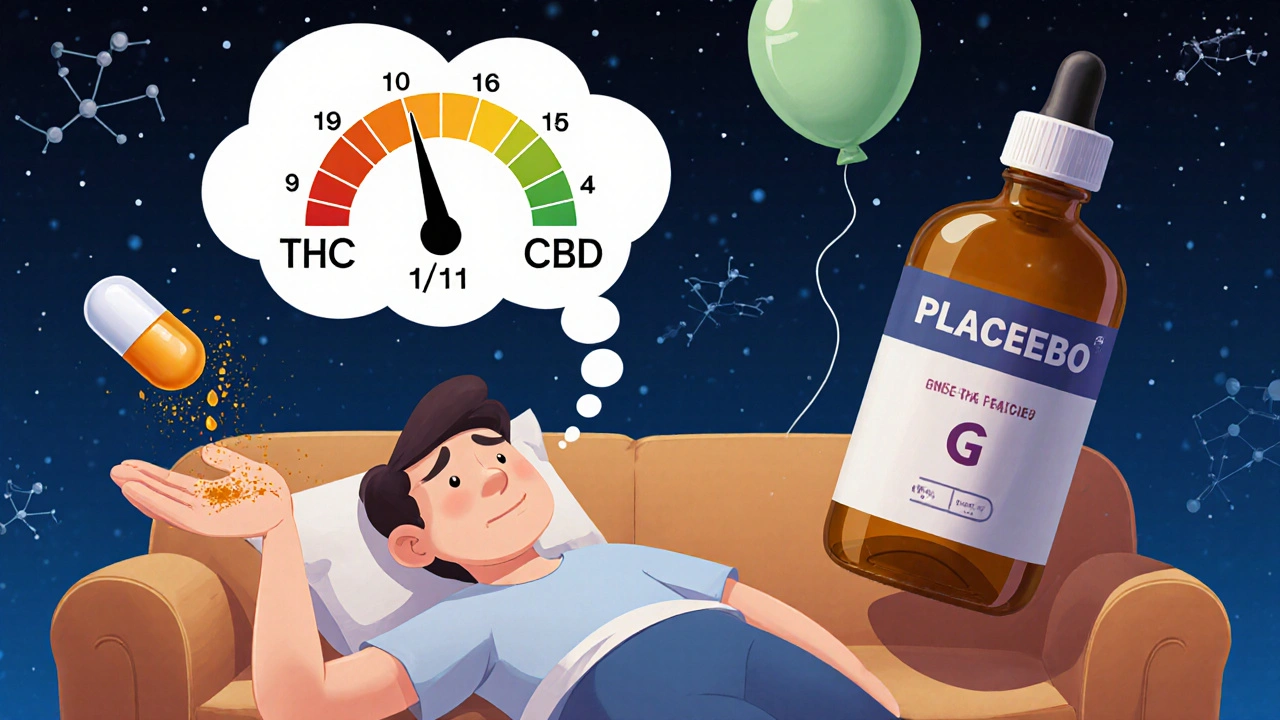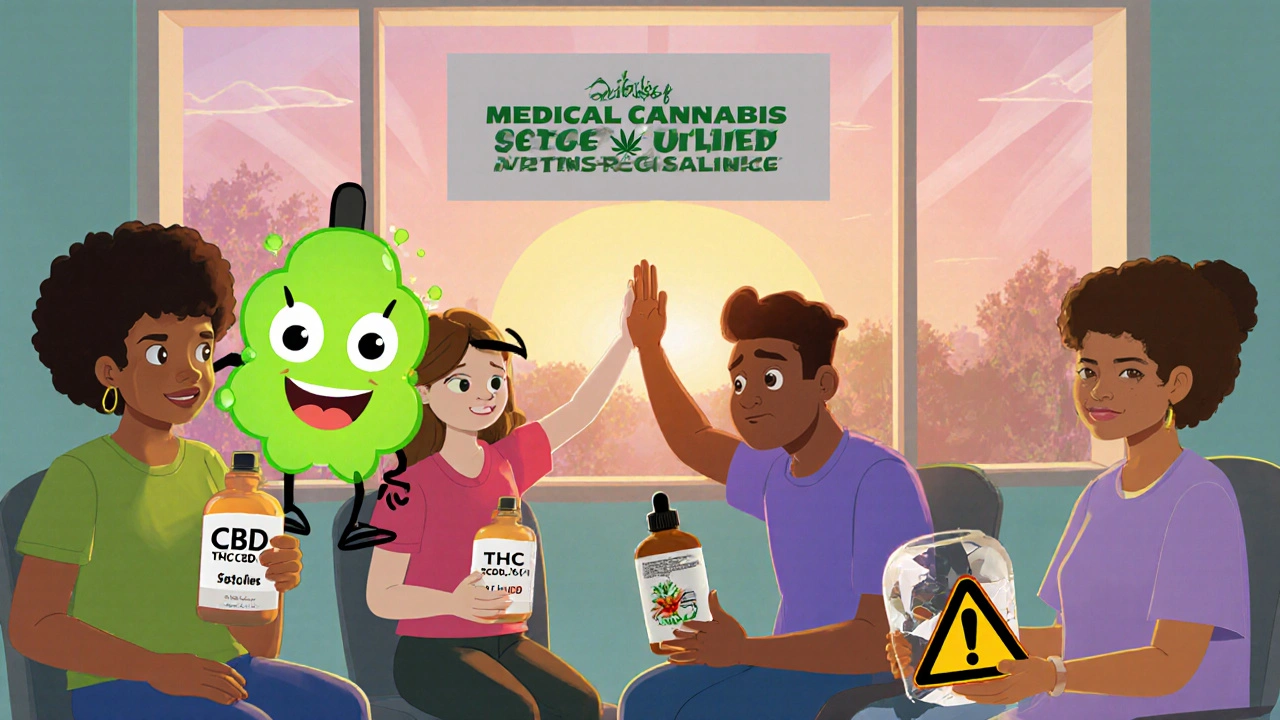For years, people with chronic pain have turned to cannabinoids-CBD, THC, CBG-hoping for relief when opioids failed or caused too many side effects. Online ads promise miracle cures. Social media is full of testimonials. But what does the science actually say? And more importantly, does it work for cannabinoids for pain, or is it just hope sold in a bottle?
What Are Cannabinoids, Really?
Cannabinoids are chemicals found in the cannabis plant. The most well-known are THC (tetrahydrocannabinol), which gets you high, and CBD (cannabidiol), which doesn’t. But there are others-CBG (cannabigerol), CBN (cannabinol)-that are gaining attention in pain research. These compounds interact with your body’s endocannabinoid system, a network of receptors that helps regulate pain, inflammation, mood, and sleep. Unlike opioids, which block pain signals in the brain, cannabinoids work more broadly. They may reduce inflammation, calm overactive nerves, and even change how your brain processes pain signals. That’s why they’re being studied for conditions like neuropathic pain, fibromyalgia, and arthritis-where traditional drugs often fall short.The Evidence: Mixed, But Not All Hopeless
Here’s the problem: the research is all over the place. A 2015 JAMA review found moderate-quality evidence that cannabinoids help with chronic pain. That’s not strong proof, but it’s not nothing. The CDC, in its 2023 update, says there’s limited evidence for most types of pain-but acknowledges some benefit for neuropathic pain, especially from THC-containing products. Then there’s the CBD contradiction. A 2023 University of Bath study analyzed 16 high-quality trials using pharmaceutical-grade CBD. Fifteen showed no better results than a placebo. Harvard Medical School echoed this, stating there’s still no high-quality human study proving CBD alone relieves pain. Yet, a January 2025 Yale study found that CBD, CBG, and CBN all reduced activity in a key pain-signaling protein in lab tests-with CBG showing the strongest effect. That’s promising, but lab results don’t always translate to real patients. The difference? THC. Products with THC-especially in a 1:1 ratio with CBD, like the FDA-approved Sativex-have more consistent results. Health Canada approved Sativex for nerve pain in multiple sclerosis and cancer pain that won’t respond to opioids. Real patients report success: one person on Leafly said switching from 120mg of oxycodone daily to a 1:1 THC:CBD tincture cut their dose to 30mg with better control and fewer side effects. So if you’re looking for pain relief, CBD alone? Probably not. THC-containing products? More likely-but with risks.Dosing: No Rules, Just Guesswork
There’s no official dosing guide for cannabinoids and pain. Why? Because the FDA hasn’t approved any cannabinoid for pain. That means no standard doses, no clear guidelines, and no oversight. Clinicians who prescribe medical cannabis typically start low: 2.5-5mg of THC or 10-20mg of CBD. Then they slowly increase, watching for effects and side effects. Some people need weeks to notice anything. Others feel changes in hours. But here’s the catch: what’s in your bottle might not match the label. The University of Bath tested over 100 CBD products sold online. Some had zero CBD. Others had up to 260% more than advertised. A few even contained illegal levels of THC. That’s not just ineffective-it’s dangerous. You could accidentally get high, fail a drug test, or expose yourself to toxins. If you’re going to try it, stick to products from licensed medical dispensaries where quality is regulated. Avoid Amazon, Walmart, or random online sellers. You’re gambling with your health.
Safety: It’s Not Risk-Free
Cannabinoids aren’t harmless. Even if they’re natural, that doesn’t mean they’re safe. THC can cause dizziness, dry mouth, nausea, and impaired coordination. In some people, it triggers anxiety or paranoia. Long-term use might affect memory or mental health, especially in younger users. CBD is often called “safe,” but that’s misleading. High doses can cause liver toxicity, as shown in multiple studies. It also interacts with over 100 common medications-blood thinners, antidepressants, seizure drugs-by messing with liver enzymes. If you’re on any prescription meds, talk to your doctor before trying CBD. And don’t forget the legal mess. Federally, cannabis is still a Schedule I drug in the U.S., meaning it’s classified with heroin and LSD. That makes research hard, banking difficult, and product quality unreliable. Even in states where it’s legal, you’re navigating a wild west market.Who Might Benefit-and Who Should Avoid It
Cannabinoids might be worth trying if:- You have neuropathic pain (nerve pain from diabetes, shingles, or injury)
- You’ve tried opioids, NSAIDs, or antidepressants with little success
- You’re looking to reduce opioid use under medical supervision
- You’re under 25 (brain development risk)
- You have a history of psychosis or bipolar disorder
- You’re pregnant or breastfeeding
- You’re on medications that interact with cannabinoids
What’s Next? The Science Is Still Unfolding
There are over a dozen phase III clinical trials underway right now. One at Columbia University is testing CBD for chronic low back pain. Another from GW Pharmaceuticals is studying a THC:CBD combo for cancer pain. Results are expected by 2025. If those trials show clear benefit, the FDA could approve a cannabinoid-based pain medication by 2027. That would mean standardized doses, verified purity, and insurance coverage-something the current market can’t offer. In the meantime, the most promising cannabinoid for pain might not be CBD or THC-but CBG. Early lab data suggests it’s powerful, non-intoxicating, and possibly safer. But it’s not available in consumer products yet. Only in research labs.
Real People, Real Results
Reddit threads and patient forums tell a story of frustration and hope. One user, u/PainWarrior22, said CBD oil cut their fibromyalgia pain by 30% after two weeks. Another, u/TruthSeeker87, spent $400 on gummies and felt nothing. Trustpilot reviews for top CBD brands show an average of 3.2 out of 5. The most common complaint? “No pain relief.” The people who report real success usually use THC-containing products, not pure CBD. And they’re often under medical care, not self-medicating from a random website.Bottom Line: Be Smart, Not Hopeful
Cannabinoids aren’t magic. They’re not a cure-all. But they’re not a scam either. If you have chronic pain and conventional treatments haven’t worked, cannabinoids might be an option-but only if you approach them like medicine, not a supplement.- Start with low doses
- Use only regulated, lab-tested products
- Avoid pure CBD for pain-look for THC:CBD combinations
- Talk to your doctor before starting
- Don’t stop your other meds without guidance
Can CBD alone relieve chronic pain?
Current high-quality evidence says no. Multiple randomized trials, including a 2023 University of Bath analysis of 16 studies, found CBD performs no better than a placebo for chronic pain. While some people report feeling better, this may be due to reduced anxiety or improved sleep-not direct pain relief. The FDA has not approved CBD for pain, only for rare epilepsy syndromes.
Is THC safer than opioids for pain?
THC is less likely to cause fatal overdose than opioids, which killed over 80,000 people in the U.S. in 2023. But THC isn’t risk-free. It can impair coordination, worsen anxiety, and lead to dependence. While opioids lose effectiveness over time and carry high addiction risk, THC offers modest pain relief for some, especially nerve pain. For many, a low-dose THC:CBD combo may be a safer alternative than high-dose opioids-but only under medical supervision.
What’s the best way to take cannabinoids for pain?
Tinctures (oil drops under the tongue) and capsules offer the most consistent dosing. Smoking or vaping delivers faster relief but harms the lungs. Edibles are unpredictable-effects can take 2 hours to kick in and last all day. Topicals (creams, patches) may help localized pain like arthritis but won’t affect nerve or deep tissue pain. For reliable results, stick to medical-grade products with known THC:CBD ratios.
Can I use cannabinoids with my other pain meds?
CBD and THC interact with the liver’s CYP450 enzyme system, which processes many common drugs-including blood thinners, antidepressants, seizure medications, and statins. This can raise or lower drug levels in your blood, leading to side effects or reduced effectiveness. Always tell your doctor what you’re taking. Never combine cannabinoids with opioids or sedatives without medical oversight.
Are over-the-counter CBD products safe?
No. A 2023 University of Bath study found that 70% of online CBD products contained less CBD than labeled, and 20% had illegal levels of THC. Some had pesticides, heavy metals, or synthetic cannabinoids. The FDA has issued over 140 warning letters to companies making false pain claims. Only products from licensed medical dispensaries or regulated pharmaceutical sources can be trusted for purity and accuracy.
Will I fail a drug test if I use medical cannabis?
Yes, if the product contains THC-even in small amounts. Most workplace drug tests screen for THC metabolites, not CBD. Full-spectrum cannabis products, even those labeled “low-THC,” can trigger a positive result. Broad-spectrum and isolate CBD products without THC are safer-but still not guaranteed. If your job requires drug testing, avoid all cannabis-derived products unless you have written medical permission.
Is CBG the next big thing for pain relief?
Early lab research from Yale in January 2025 suggests CBG is more potent than CBD or THC at blocking a key pain-signaling protein. It’s non-intoxicating and may have fewer side effects. But it’s not yet available in consumer products. No clinical trials in humans have been completed. CBG shows promise, but it’s still years away from being a proven treatment.
What to Do Next
If you’re considering cannabinoids for pain:- Speak to a pain specialist or doctor familiar with medical cannabis
- Ask about clinical trials in your area
- Only use products from regulated dispensaries
- Track your symptoms daily-note pain levels, sleep, mood
- Give it at least 4-6 weeks before deciding if it works

